Bearded dragons come in many different “morphs”. This guide will cover 14 different bearded dragon morphs you should check out.
You’ll learn:
- What is meant by “morph”?
- What are the different types of bearded dragon morphs?
- How can you buy one from an ethical source?
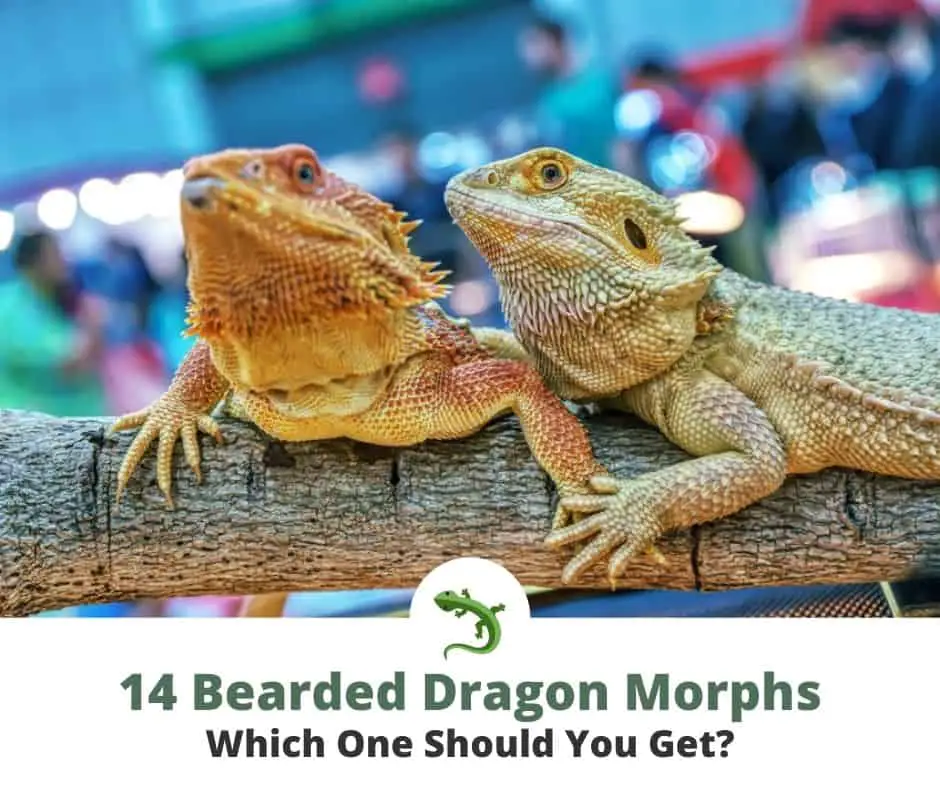
Bearded dragons are reptiles native to the warm, arid deserts and woodlands of Australia. They are known for their spiky scales along their flanks and a beard that puffs up depending on their mood giving them their name. Because of their popularity as pets, different morphs or varieties are available in the market.
There are eight known species, four of which are kept as pets. The most popular one found in captivity is the Pogona vitticeps or the Central Bearded Dragon. They are normally colored tan, yellow, or brown (sometimes with red or orange markings) but different colors have arisen due to selective breeding in captivity.
Most, if not all bearded dragon morphs are of the same species, P. vitticeps since these are the most widespread in captivity. Though there is some work on crossing morphs of P. vitticeps with the Eastern bearded dragon (P. barbata).
What Is Meant By “Morph”?
A morph is a term used to describe a bearded dragon’s overall appearance such as its body type, scales (or lack of), and size. The terminology also applies to other lizards and reptiles such as ball pythons and iguanas.
Fun Fact
Different bearded dragon morphs arose due to the artificial selection or selective breeding of bearded dragons with desirable traits or characteristics. Two individuals from different clutches with favorable traits are bred with each other to increase the chances of the next generation demonstrating that trait and so on.
Unique or rare bearded dragon morphs cost more than the standard or classic bearded dragon normally found in pet shops which closely resemble those found in the wild.
📚 Read More >> How Much Do Bearded Dragons Cost?
The terminology “morph” should not be confused with “color.” Bearded dragon morphs and their specific characteristics can appear on a bearded dragon of any color. There is a set of bearded dragon morphs recognized as the standard in the legitimate breeding community and these are named after their characteristic, not their color.
A dragon’s morph can affect its color and pattern but “morph”, in the technical sense, describes a beardie’s body type and overall appearance and body type – not color.
Pro-tip
Keep in mind that color (and to some extent, pattern) descriptions of a bearded dragon morph can vary widely and are subjective (depending on the breeder). Inexperienced buyers might be impressed by a “citrus fire engine red-orange leatherback” and think it’s an entirely different morph because of the cool name and thus be prepared to pay more. It’s best to do your research before making a final purchase.
In the simplest sense, different bearded dragon morphs can be loosely likened to different dog breeds (but when it comes down to the details, a breed is different from a morph mainly on the length of generations used to tease out a breed).
14 Types Of Bearded Dragon Morphs
Bearded dragon morphs are being discovered all the time so this list is not all-inclusive. It is a compilation of the common and established bearded dragon morphs in the community.
In general, some morphs affect the pattern, absence, or presence of scales and spikes on a bearded dragon’s body. These scalation morphs are Leatherbacks, Silkies, Microscale, and Dunner. Morphs can also affect the skin’s melanin content and patterns. These are Hypomelanistic, Translucent, Zero, Genetic Stripe, Witblits, Wero, Paradox, and Silverbacks. Dunners are also a pattern morph. And finally, the only morph that affects size is the German Giant.
- Classic, Normal, or Standard
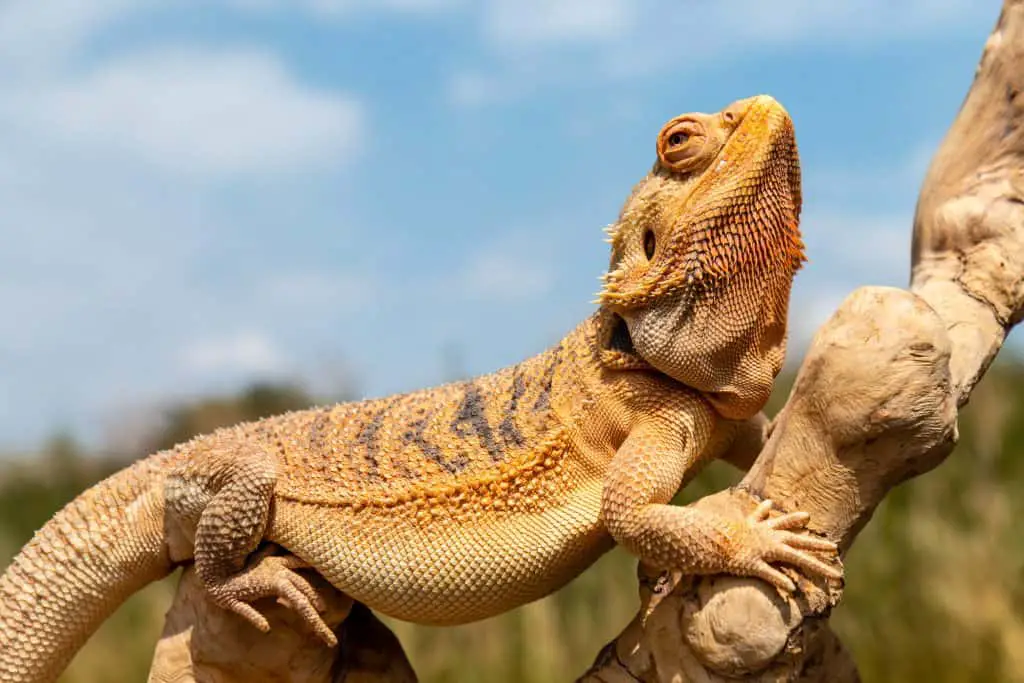
Classic or standard bearded dragons, also known as “wild-type” are beardies that closely resemble those found in the wild. These individuals have genes that are closest to the original, standard genetic stock of P. vitticeps.
Classic bearded dragons have natural brown, tan, or yellow colors that they’d normally use to camouflage in sandy deserts. They have a full, spiky beard, a broad triangular head, and spikes along their flanks and spine.
Fun Fact
A bearded dragon’s spikes or spines are also called tubercles which are raised scales or an outgrowth on their skin.
Some classic bearded dragon morphs have dark stripes running perpendicular to their spine resembling the coat of tigers. They may also come with patterns or shades of red, yellow, or orange.
- Hypomelanistic
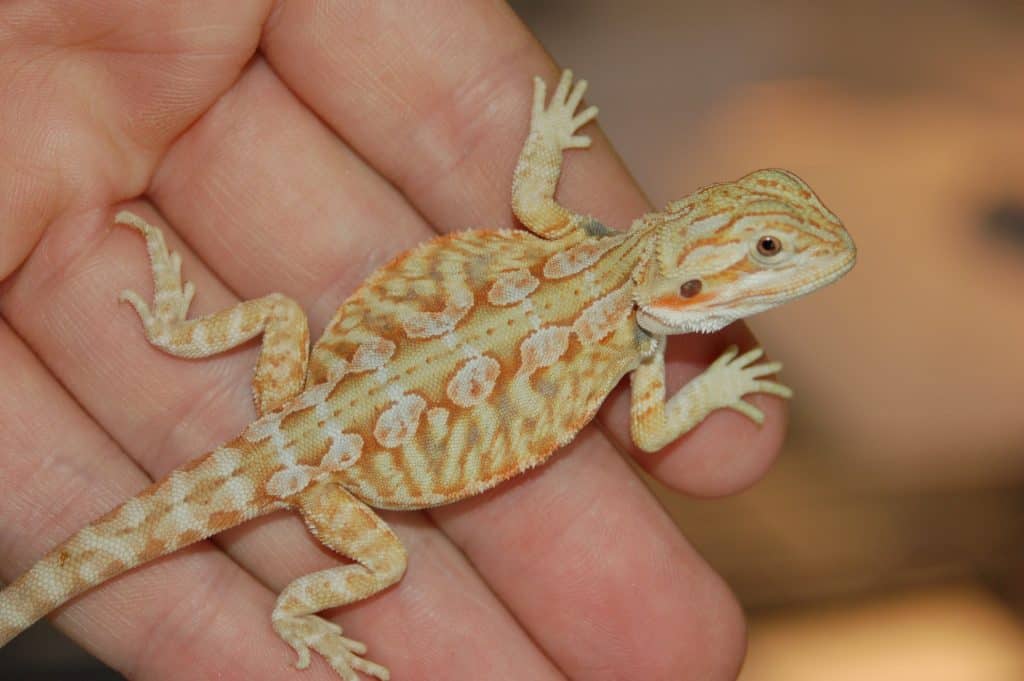
“Hypo” means low or below normal and “melanin” is the pigment responsible for darker colors on the skin of bearded dragons. The Hypomelanistic morph is known for its lighter skin color and clear nails. This is caused by a mutation that causes their body to produce less melanin. They are born brightly colored and grow paler with age.
The hypomelanistic mutation can also affect other bearded dragon morphs so other varieties are hypo-translucent, hypo-leatherback, hypo-witblits dragon, etc.
Hypos can also be called “pastels” and other types include Hypo Snow, Hypo Yellow, Red Het Hypomelanistic, Yellow Hypo, Blood Hypo Orange, Hypo Het Translucent, and more.
- Leatherback
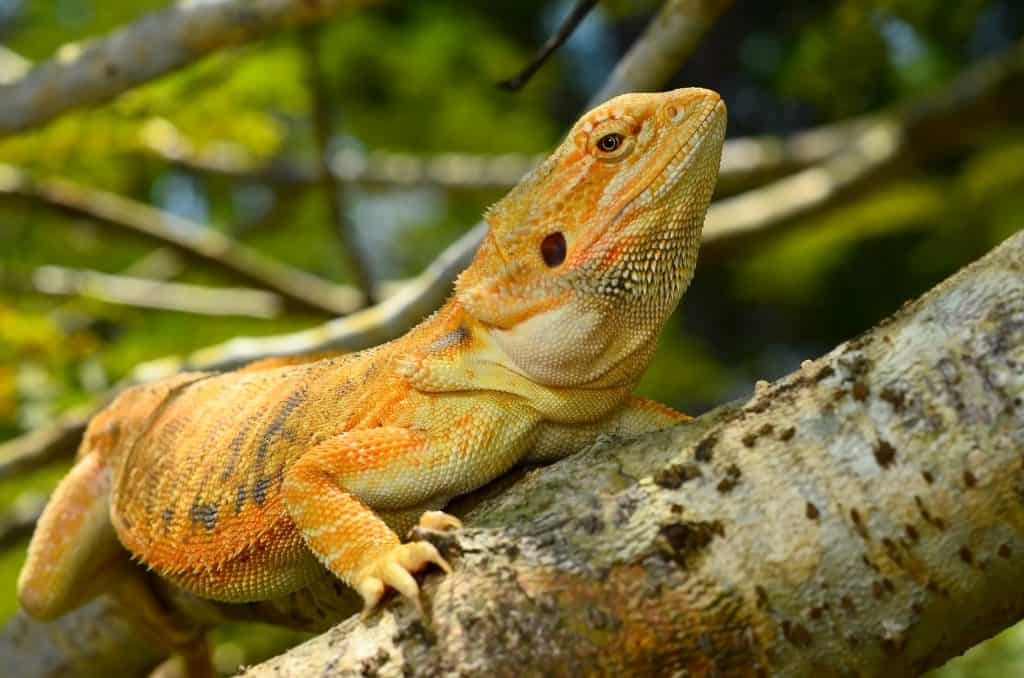
Leatherbacks are morphs with more vivid colors on their backs due to the missing ridge of spikes or scales along their back. The absence of these spikes also makes their skin feel a bit smoother. Some Leatherbacks will have small spikes or protruding large scales along their backs.
Leatherbacks are closely related to Silkback bearded dragons. Leatherbacks are co-dominant heterozygous while Silkbacks are homozygous. The Leatherback morph is quite rare, making them more expensive.
Some varieties include Het Hypomelanistic Leatherback, Hypo Leatherback, and Hypo Translucent Leatherback Dunner.
- Microscale
Bearded dragons that have smaller and fewer spikes than Leatherbacks are called Microscale. They lack or have smaller and fewer spikes on their beards and flanks.
These morphs are a result of breeding a Leatherback with two dominant Leatherback genes with a Leatherback that has one recessive gene. The clutch will have Microscale hatchlings.
- Silkback, Silkie, or Scaleless
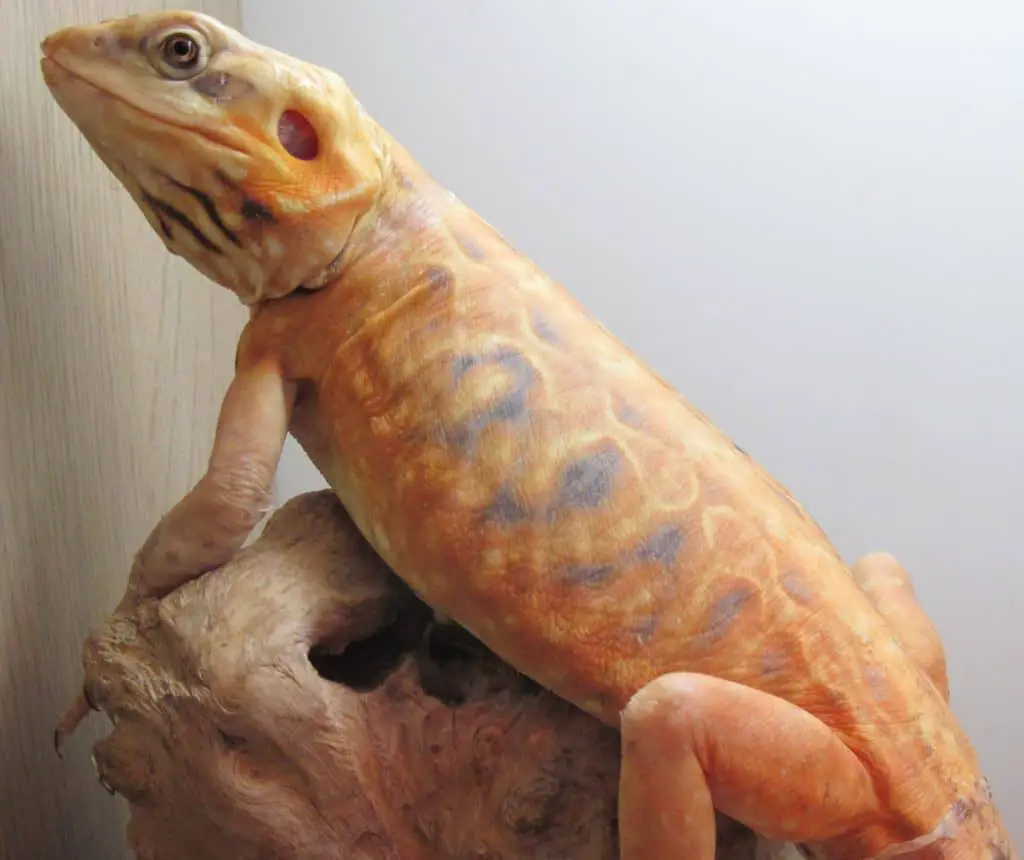
Silkback bearded dragons are completely scaleless giving these bearded dragons a more amphibian look with their smooth, soft, skin with vibrant colors. Due to the lack of protection from scales or spikes, silkies are very delicate and need more attention in terms of skincare, enclosure setup, and lighting. Regular baths and moisturizers will help promote good circulation and prevent dried skin from cutting off blood flow to their extremities.
📚 Read More >> Best Bearded Dragon Enclosures
Fact
A study by Sakitch and Tattersall in The Journal of Experimental Biology (2021) on classics, leatherbacks, and silkies show that silkies lost water twice as much as classic or leatherback morphs but do not adjust their thermal preferences based on this water loss.
This means that if a silkie is feeling cold, it will still aim to reach the same, higher body temperature as a classic or leatherback morph would without adjusting to or knowing about the consequences of increased dehydration or water loss because of their lack of scalation. Though they have been bred to be without scales, they have not exactly evolved to adapt to this mutation, putting into question this morph’s welfare and quality of life.
Silkbacks can be born with missing toes and parts of their tails. They are easily wounded and should be kept alone to prevent injuries from aggression. Their tanks should be free from any sharp objects. Heating and UVB lighting should be milder and attached further from basking spots. Silkbacks may also have trouble regulating UV rays so the lamp should only cover half of the enclosure.
📚 Read More >> Best Lighting For Bearded Dragons
Important
The ethics of rearing Silkbacks have been questioned since breeding can be quite aggressive especially for females, leading to more injuries due to their delicate skins, and caring for them successfully can be quite a challenge. This puts into question their quality of life hence the debate on breeding silkbacks.
- Translucent
Translucent or Trans bearded dragons have thin, semi-transparent skin and scales that allow the dark-colored membrane of their inner organs to be seen. This gives the skin on their bellies and backs a bluish hue. They can also have very dark, black eyes that sometimes change into the standard yellow ones as they mature. As these beardies age, their skin thickens and the bluish tint fades or goes away.
Types of Trans morph you may encounter are Red and Orange Hypo Translucent, Rally Red Trans, Dark Translucent, Hypo Het Translucent, and Hypo Translucent Genetic Stripe.
Bearded dragons described as blue, violet, or purple are quite rare and are Trans morph that retained their bluish tinge into adulthood.
There’s a myth surrounding Translucent bearded dragon morphs stating that they are prone to health problems but they have been successfully bred for many years.
- Dunner
Dunners have discontinuous markings that run vertically instead of the typical horizontal stripes. This gives Dunners their distinct spots or blotches pattern. They also have bigger feet and broader tails. Their scales do not run from head to tail and instead point in different directions (mostly sideways) with the spikes on their beard jutting out sideways instead of downward.
They also have this peculiar trait of keeping food at the back of their throats before swallowing. Young Dunners may even regurgitate their food instead of swallowing it but they outgrow this behavior as they mature.
Dunner varieties include Hypo Translucent Dunner, Hypo Translucent Leatherback Dunner, Yellow or Citrus Hypo Dunner, and Hypomelanistic Dunner.
Fun Fact
The name comes from the first person that bred these morphs, Kevin Dunn.
- Zero
The Zero morph is a type of leucistic dragon that does not have the usual markings (patterns and colors) that standard bearded dragons have. Their lack of markings is a recessive trait. They are usually silver or gray with the hypomelanistic Zero morphs having an almost white color. Hypomelanistic Zero morphs can sometimes be called Snow bearded dragons. Zero morphs are quite rare and are therefore expensive.
- Genetic Stripe
Bearded dragons with a distinct stripe along their backs at each side of the spine are called the Genetic Stripe. The stripe starts from their necks and extends into just past the base of the tail. This mutation is a dominant trait.
Pro-tip
The “Genetic Stripe” with the dominant gene responsible for the particular striped pattern is the true morph. However, breeders have used the word “stripe” as an adjective to describe dragons that may not be a true morph “Genetic Stripe.” The stripe pattern for these may have been caused by a combination of factors instead of the specific gene for the true Genetic Stripe.
- German Giant
German Giants are classic or standard bearded dragons that can grow up to 25 inches (some grow to 30 inches!) but unfortunately, it’s almost impossible to tell until they are fully grown. A few signs that indicate you have a German Giant aside from being significantly longer from snout to tail, include high aggression and brown or tan colors. If you suspect you have a German Giant then you should get a much bigger tank (at least 120 gallons and up).
There’s not a lot of purebred giants left due to cross-breeding with other morphs to strengthen the genetic stock.
- Witblits
Witblits are another leucistic morph with no patterns or markings and have muted colors. Though the name is South African for ‘white lightning,’ they are not quite white and appear grey or have dull brown or muted orange colors. These traits are caused by a recessive gene.
They differ from the Zero morph by the absence of the black color on their shoulders. Witblits is a relatively new morph and is rare and expensive.
- Wero
A Wero resulted from breeding a Zero and Wilblits and is relatively new in the breeding community. Weroes closely resemble Zeroes except for some dark coloration on its side and at the base of the tail. Some Weroes can appear completely patternless and are close to a white color.
- Paradox
Paradox bearded dragons are prized and rare dragons characterized by a solid base color (usually grey or off-white) that develops random patterns or patches in a different color. These look like paint splashes upon maturity. Their value is often judged by their color and how different their pattern looks (paradox shifts).
The gene associated with the coloration has not been isolated and is considered an anomaly or a combination of different mutations, unlike the other morphs whose mutation can be traced to a specific gene.
The Paradox bearded dragon has not been consistently reproduced through breeding and is sometimes not considered true morphs.
- Silverback
Silverbacks are another leucistic morph that has no pattern and are mostly off-white, grey, or brown. They have markings when born which fade over time. Silverbacks originated from Japan and are not common in the US. The market in the US favors witblits and zeros that are closer to white in color.
Color and Patterns
To a certain extent, bearded dragons can change their color depending on their mood, for communication, as camouflage, or as a means to regulate their body temperature. They are well known for their blackened beards when they’re aggressive or territorial.
The colors below will refer to a bearded dragon’s “resting” color but don’t be surprised if your red bearded dragon becomes a bit darker throughout the day. Darker colors absorb more heat so a darker bearded dragon is just trying to warm up a bit.
Pro-tip
Bearded dragons with different colors and patterns can sometimes be confused as different morphs. Keep in mind that bearded dragons can have different colors and patterns and still be the same morph. Color or pattern names are added to the morph name to give it a more detailed description.
The usual color and pattern names used to describe bearded dragon morphs are as follows. Again, color or pattern description can be subjective, so the names are sometimes used interchangeably for similar hues and can largely depend on the breeder.
| Color or Pattern | Other names; description |
| Red | Citrus, blood red, ruby red; most desired colors but can vary greatly in terms of shade and saturation (bright red, muted maroon, and almost pink) |
| Orange | Sunburst, citrus, tangerine; also sought after in the bearded dragon community. |
| Brown, Tan | Beige, sandy brown; most common bearded dragon colors |
| Yellow | Sandfire, lemon, gold, sometimes citrus; can also be a soft pastel for hypo morphs |
| White, Grey, or Silver | Off-white, snow; used most often to describe leucistic morphs like the Zero and Witblit |
| Blue, Violet, or Purple* | *These colors are quite rare and are usually used for translucent morphs that carry their bluish tinge into adulthood so be wary as a lot of bearded dragons described with these colors could be fake. |
| Tiger pattern | The most common pattern description for dark horizontal lines along a beardie’s back resembling a tiger pattern. Bearded dragons with darker and more distinct lines have greater value. |
| Spots or blotches pattern/ Dunner pattern | Most often describes the Dunner morph whose irregular markings make it appear like it has spots instead of the usual pattern. |
| Stripes pattern | Can be used to describe patterns that are similar to stripes but should not be confused with the “Genetic Stripe” morph. Other morphs of bearded dragons may have patterns that resemble stripes but are not necessarily the “Genetic Stripe” morph. |
Morph Terminology
Genes
Different reptile morphs arise because of genetics. Genes are the stock codes of reptiles (and all living things) that determine physical characteristics and behavioral traits. Minor differences in the genes of individuals lead to different traits which can either be dominant or recessive. A set of an organism’s genes is also referred to as its “genotype.”
Fun Fact
Mutations in the genes give rise to different traits. In the wild, these mutations are usually “weak” characteristics like fewer scales and will often die out due to natural selection/evolution. In captivity, these weaknesses are considered unique and rare and are selectively bred to help the trait emerge.
Phenotype
A phenotype is an organism’s observed trait or general appearance expressed by its genotype. A bearded dragon’s specific color, shape, size, and behavior is its phenotype.
Homozygous and Heterozygous Alleles; Recessive Traits and Dominant Traits
Alleles are proteins in genes that determine if a specific trait is recessive or dominant. All genes have a pair of alleles and these alleles can either be dominant or recessive.
A gene with a pair of alleles that are the same is homozygous; if the alleles are not the same, they are heterozygous.
The picture above, from left to right, shows a homozygous dominant gene, a heterozygous gene, and a homozygous recessive gene.
A dominant allele for a certain trait will always be expressed in the phenotype while a recessive allele for a certain trait must be homozygous for the trait to be expressed in the phenotype.
If an organism’s gene carries an allele for a recessive trait and another allele for a dominant trait, the dominant trait will be expressed and the organism is considered heterozygous (het) for that recessive trait.
Fun Fact
A lot of characteristics for bearded dragon morphs came from recessive traits.
Another way to look at it would be recessive traits will be expressed if these are passed down from both parents while dominant traits will be seen in the phenotype even if one parent carries it.
Pro-tip
You will also encounter the term “het” used in a bearded dragon morph name which is short for heterozygous.
Co-dominant trait
Sometimes, traits can be co-dominant and can be expressed as different phenotypes in the same generation depending on whether or not the organism is heterozygous or homozygous for that dominant trait.
Proven
In the bearded dragon or reptile morph breeding community, this term refers to an organism morph that has been successfully bred.
Leucism
Leucism is used to describe an animal that has a significantly reduced amount of melanin giving lighter, patchy, or paler colors. It may also describe the absence of the usual patterns on the organism’s skin. Leucistic organisms do not have red eyes as albinos do.
Albinism
Albino organisms have zero melanin giving them their distinctive red or pink eyes and very pale to almost white coloration. As of writing, there is no documented albino bearded dragon. What some breeders may advertise as “albinos” are probably leucistic dragons that are white or very pale.
Unconfirmed reports indicate albino hatchlings that appear weak and unhealthy, eventually dying. Because of the lack of melanin, they are expected to have trouble absorbing UV rays which is essential to healthy growth.
Morph Related Health Issues
As mentioned, morphs or different traits stem from genetic mutations that can be “weak” characteristics if they were to occur in the wild. As such, bearded dragon morphs can have some health issues associated with their unique traits.
If these are recessive traits, these morphs would have had to be line-bred heavily to express that trait in a lot of individuals within a clutch. This could mean that some pairs are related which lessens genetic diversity and genetic diversity promotes robust offspring. With less genetic diversity, other less favorable recessive mutations could emerge and next generations may become weaker.
For example, morphs that have fewer scales need extra care when it comes to their skin especially regarding injuries or shedding as scales are a form of protection for a bearded dragon.
Before purchasing a specific morph, it is important to learn about any health issues it may have because of its unique traits so you can prepare to care for it properly.
Bearded dragon morphs that have fewer scales and lack color such as hypomelanistics, leatherbacks, translucent, and silkbacks need softer UVB lighting and moisturizers to assist in shedding.
The UV bulb should be <3.0 UVI and set up to cover only half the length of the enclosure. The basking area should not be too close to the heating lamp as well.
Bearded dragons with no scales also tend to suffer from missing toes and tails, difficulty shedding, and an overall shorter lifespan.
Important
Note on responsible breeding: Different bearded dragon morphs and their unique characteristics are quite fascinating but the effort that goes into breeding requires knowledge, experience, and expertise to ensure that the wellbeing of the animal remains the top priority.
If you are interested in becoming a breeder, make sure to get in a lot of research and talk with established breeders in the community. Careless selective breeding can result in unhealthy animals who grow to have a poor quality of life or may not thrive at all.
Tips For Finding A Reputable, Ethical Breeder
- Research and read up on morphs
Reading up on morphs will make you an educated buyer which helps in identifying bogus breeders. There are several Facebook groups and forums with information from actual owners and breeders that you can easily look into.
- Stay away from large chain pet stores
Large chain pet stores are not specialized enough on exotic animals such as bearded dragons for them to put enough effort into breeding and even caring for their beardies on sale. Bearded dragons from such stores are usually kept in substandard enclosures and morphs may not be of the highest genetic quality.
Watch out for exotic pet stores instead that specifically cater to reptiles such as bearded dragons. You have a better chance of finding quality morphs and standard bearded dragons from these places.
There are also occasional reptile trade fairs that host reputable breeders.
- Ask your exotic pet veterinarian
Your local exotic pet veterinarian may also have a lot of information on reputable and ethical breeders.
- Ask questions
The best way to find and spot a reputable and ethical breeder would be to ask as many questions as you can! Responsible breeders are proud of what they do and aim to educate so they shouldn’t hesitate to ask any questions you might have. As opposed to those who may just be out to make a quick buck, good breeders will take the time to talk you through bearded dragon morphs and give you a lot of information
Other tips and information about bearded dragon morphs
- Colors and patterns may change as dragons mature
As beardies age, their colors and patterns may change, fade, become dull, or be less defined. Bearded dragons can also regulate the melanin content of their skin to some extent based on their environment (hot or cold temperatures) so they may also change in color from time to time.
- Be wary of adjectives and fancy words used to describe morphs
As mentioned above, colors and other adjectives used to describe morphs are largely subjective. These are often added to describe the morph better but may not always be a different or true morph. Often, these adjectives are used to make the description sound more interesting to buyers and justify a steeper price tag.
- Lighting makes all the difference in photos
Lighting can make colors in pictures look different. A bearded dragon’s overall look can change drastically under natural, indoor (or fluorescent), or warm lighting. Some colors will appear more vibrant in artificial lighting and eventually seem dull in real life.
If you cannot see the bearded dragon in person or a live video, at the very least, before purchasing then you should insist on getting pictures in different lighting. This ensures that you are getting what you pay for.
Some sellers can also misrepresent the pictures of their dragons for sale by using photo editing software to oversaturate the picture.
- A fancy bearded dragon is not a morph
Fancy is a general term used to describe a morph that doesn’t fit the standard descriptions. Fancy bearded dragons are a result of selective breeding similar to morphs. Often, breeders use this term if they are unsure of what the exact morph is and it is different from the classic or standard variety.
📚 Read More >> Fancy Bearded Dragons
- Pygmy is not a morph and true albinos do not exist
Some bearded dragons may be described as “pygmy” but there is no true genetic morph that produces smaller than average bearded dragons of the P. vitticeps species. It is a descriptive term but is by no means a guarantee that it will be smaller when it matures.
Take note, however, that there are bearded dragon species that are smaller in length when mature but these are very rare in captivity (e.g. Rankin’s dragon and Kimberley Bearded Dragon). These bearded dragons may be described as “pygmy bearded dragons” which is technically correct when compared to other species that are longer/larger in size.
True albino bearded dragons do not exist. So far, no documented albinos have been successfully reared. Bearded dragons that are described as albinos are usually just leucistic (have very low melanin) and thus appear very pale or white.
Conclusion
Morphs are varieties of bearded dragons that differ in specific physical characteristics which emerged due to selective breeding. Bearded dragon morphs usually have distinct looks, colors, or patterns that make them more visually appealing and often, more expensive.
Though there are a handful of “standard” morphs in the breeding community, morph descriptions can vary immensely and can become quite overwhelming.
If you are planning to get a bearded dragon morph, it’s best to educate yourself so you can make an informed decision. Morphs may have specific care requirements so you should be prepared for that as well.
FAQs
Do blue bearded dragons exist?
Yes but the bluish tinge usually fades with age. These are Translucent bearded dragon morphs that have a distinct bluish hue on their bellies and sides that fade as they age. The Trans morph is quite rare and they are not a solid blue color as many imagine. The bluish hue is because of their thinner skin and scales that allow the black membrane encasing the inner organs to show.
What is the rarest bearded dragon color?
The blue or purple color of the Translucent bearded dragon morph is quite rare because the bluish tinge usually fades as these beardies mature.
What is the cheapest bearded dragon morph?
The cheapest bearded dragon morph is the standard or classic morph. Classic morphs with brighter markings, tiger patterns, or red/orange hues tend to be more expensive.
Further Reading
Overview on Bearded Dragons:
Bearded dragons: facts and photos
Short but informative manual on bearded dragon care (written by a vet):
Caring for the Bearded Dragon
A full and exhaustive guide to bearded dragons from taxonomy, history, behavior, breeding, and many more:
Husbandry Manual For Bearded Dragons. Reptilia: Agamidae
A study on bearded dragons with fewer scales:
Bearded dragons (Pogona vitticeps) with reduced scalation lose water faster but do not have substantially different thermal preferences | Journal of Experimental Biology
Myths and facts about bearded dragon care:
Myths and Facts about Bearded Dragon Care


